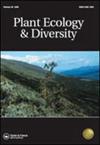扩大木材解剖经济学范围:热带森林树木血管元件长度和凹坑孔径大小的相关性
IF 1.6
4区 生物学
Q2 PLANT SCIENCES
引用次数: 2
摘要
摘要背景植物的功能都有解剖学基础,但在功能木材解剖学,尤其是热带树木的功能木材解剖学方面,仍存在较大的知识空白。目的研究研究较少的热带雨林树木木质组织的功能解剖之间的关系,重点研究解剖特征,包括导管元件长度、凹坑孔径尺寸、分组指数和木质部组织分数。我们研究了这些解剖特征如何影响干旱脆弱性指数、理论电导率和结构特征,如木材密度和树干直径。方法对25个大西洋雨林物种的木材解剖特征和高级结构特征进行了测量,并采用单变量和多变量方法检验了这些特征之间的关系。回归模型用于探索解剖特征与干旱脆弱性、理论电导率和木材结构特征之间的关系。结果易损性指数与薄壁组织分数、血管间和血管内射线坑孔径呈正相关。理论电导率与纤维分数呈负相关。木材密度与纤维分数呈正相关,也与薄壁组织和血管分数以及血管元件长度有关。结论解剖性状是一个重要的经济学谱,可以将其与叶经济学谱相比较,以进一步了解植物的生态和水力策略。本文章由计算机程序翻译,如有差异,请以英文原文为准。
Expanding the wood anatomy economics spectrum: the correlates of vessel element lengths and pit apertures sizes in tropical forest trees
ABSTRACT Background Plant functions all have an anatomical basis, but there are still major knowledge gaps in functional wood anatomy, especially of tropical trees. Aims To examine the relationships between the functional anatomy of woody tissue in poorly studied rainforest trees, focussing on anatomical traits including vessel element lengths, pit aperture dimensions, grouping indices and xylem tissue fractions. We examined how these anatomical traits influence drought vulnerability indices, theoretical conductivity and structural traits such as wood density and stem diameter. Methods We measured wood anatomical traits and higher-level structural traits from 25 Atlantic rainforest species and examined the relationships among these traits using univariate and multivariate methods. Regression models were used to explore how anatomical traits were related to drought vulnerability, theoretical conductivity, and wood structural traits. Results Vulnerability index was positively correlated with parenchyma fraction and both intervessel and vessel-ray pit aperture diameters. Theoretical conductivity was negatively associated with fibre fractions. Wood density was positively associated with fibre fraction and was also related to parenchyma and vessel fractions and vessel element lengths. Conclusions Anatomical traits constitute an important economics spectrum, which could be positioned against leaf economics spectra to further our understanding of plant ecological and hydraulic strategies.
求助全文
通过发布文献求助,成功后即可免费获取论文全文。
去求助
来源期刊

Plant Ecology & Diversity
PLANT SCIENCES-
CiteScore
3.30
自引率
0.00%
发文量
26
审稿时长
3 months
期刊介绍:
Plant Ecology and Diversity is an international journal for communicating results and novel ideas in plant science, in print and on-line, six times a year. All areas of plant biology relating to ecology, evolution and diversity are of interest, including those which explicitly deal with today''s highly topical themes, such as biodiversity, conservation and global change. We consider submissions that address fundamental questions which are pertinent to contemporary plant science. Articles concerning extreme environments world-wide are particularly welcome.
Plant Ecology and Diversity considers for publication original research articles, short communications, reviews, and scientific correspondence that explore thought-provoking ideas.
To aid redressing ‘publication bias’ the journal is unique in reporting, in the form of short communications, ‘negative results’ and ‘repeat experiments’ that test ecological theories experimentally, in theoretically flawless and methodologically sound papers. Research reviews and method papers, are also encouraged.
Plant Ecology & Diversity publishes high-quality and topical research that demonstrates solid scholarship. As such, the journal does not publish purely descriptive papers. Submissions are required to focus on research topics that are broad in their scope and thus provide new insights and contribute to theory. The original research should address clear hypotheses that test theory or questions and offer new insights on topics of interest to an international readership.
 求助内容:
求助内容: 应助结果提醒方式:
应助结果提醒方式:


